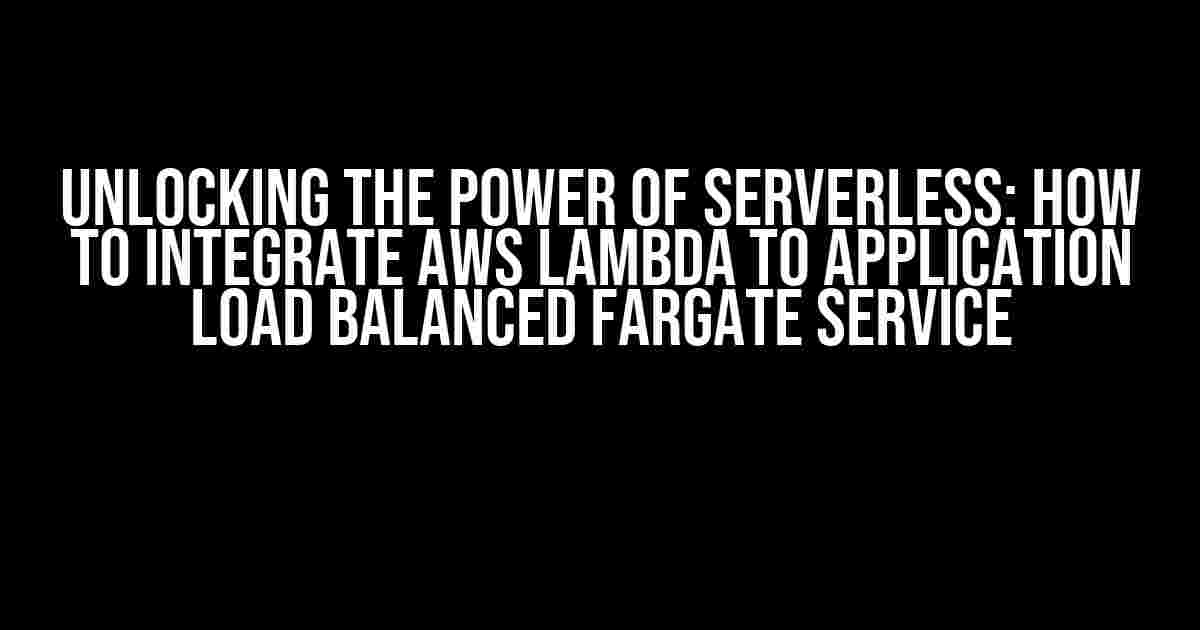Are you tired of worrying about server management and scaling? Do you want to focus on writing code and delivering value to your customers? Look no further! In this article, we’ll guide you through the process of integrating AWS Lambda to an Application Load Balanced Fargate Service, unlocking the full potential of serverless computing.
- What is AWS Lambda?
- What is Fargate?
- What is Application Load Balancer (ALB)?
- The Benefits of Integrating AWS Lambda to Application Load Balanced Fargate Service
- Step 1: Create an AWS Lambda Function
- Step 2: Create an Fargate Service
- Step 3: Create an Application Load Balancer (ALB)
- Step 4: Create a Target Group
- Step 5: Register the Fargate Service as a Target
- Step 6: Create an ALB Listener
- Step 7: Integrate AWS Lambda to the ALB
- Conclusion
- Additional Resources
What is AWS Lambda?
AWS Lambda is a serverless compute service that runs your code in response to events. It provides a highly scalable and cost-effective way to execute code without worrying about provisioning or managing servers. With Lambda, you can focus on writing code and let AWS handle the heavy lifting.
What is Fargate?
Fargate is a compute engine for containers that allows you to run containers without managing servers or instances. It provides a highly scalable and secure way to deploy containerized applications. With Fargate, you can focus on building and deploying your application, while AWS handles the underlying infrastructure.
What is Application Load Balancer (ALB)?
An Application Load Balancer (ALB) is a load balancer that distributes incoming traffic across multiple targets, such as EC2 instances, containers, and Lambda functions. It provides a highly available and scalable way to handle traffic to your application. With ALB, you can route traffic to multiple targets, ensuring high availability and scalability.
The Benefits of Integrating AWS Lambda to Application Load Balanced Fargate Service
Integrating AWS Lambda to an Application Load Balanced Fargate Service provides several benefits, including:
- Serverless Architecture: With Lambda, you don’t need to worry about provisioning or managing servers. This allows you to focus on writing code and delivering value to your customers.
- High Scalability: Fargate and ALB provide a highly scalable way to handle traffic to your application. You can easily scale your application to handle changes in traffic.
- Cost-Effective: With Lambda and Fargate, you only pay for the compute time and resources you use. This can lead to significant cost savings compared to traditional server-based architectures.
- Improved Security: With ALB, you can configure SSL/TLS certificates and leverage Amazon Web Services’ (AWS) security features to protect your application.
Step 1: Create an AWS Lambda Function
Before you can integrate Lambda to an Application Load Balanced Fargate Service, you need to create a Lambda function. Here’s how:
aws lambda create-function \
--function-name my-lambda-function \
--runtime nodejs14.x \
--role execute-role \
--handler index.handler \
--zip-file file://lambda-function.zip
In this example, we’re creating a Lambda function named “my-lambda-function” with a Node.js 14.x runtime, an execution role, and a handler named “index.handler”. We’re also uploading a ZIP file containing our Lambda function code.
Step 2: Create an Fargate Service
Next, you need to create an Fargate service that will act as the target for your ALB. Here’s how:
aws ecs create-service \
--cluster my-cluster \
--service-name my-fargate-service \
--task-definition my-task-definition \
--desired-count 1 \
--launch-type FARGATE \
--network-configuration "awsvpcConfiguration={subnets=[subnet-12345678],securityGroups=[sg-12345678],assignPublicIp=ENABLED}"
In this example, we’re creating an Fargate service named “my-fargate-service” in a cluster named “my-cluster”. We’re specifying a task definition, a desired count of 1, and a launch type of FARGATE. We’re also configuring the network settings to use a specific subnet and security group.
Step 3: Create an Application Load Balancer (ALB)
Next, you need to create an ALB that will distribute traffic to your Fargate service. Here’s how:
aws elbv2 create-load-balancer \
--name my-alb \
--subnets subnet-12345678 \
--security-groups sg-12345678
In this example, we’re creating an ALB named “my-alb” in a specific subnet and security group.
Step 4: Create a Target Group
Next, you need to create a target group that will register your Fargate service as a target for your ALB. Here’s how:
aws elbv2 create-target-group \
--name my-target-group \
--protocol HTTP \
--port 80 \
--vpc-id vpc-12345678
In this example, we’re creating a target group named “my-target-group” with a protocol of HTTP, a port of 80, and a VPC ID.
Step 5: Register the Fargate Service as a Target
Next, you need to register your Fargate service as a target for your target group. Here’s how:
aws elbv2 register-targets \
--target-group-arn arn:aws:elasticloadbalancing:REGION:ACCOUNT_ID:targetgroup/my-target-group \
--targets "Id=my-task-definition,Port=80"
In this example, we’re registering our Fargate service as a target for the target group, specifying the task definition and port 80.
Step 6: Create an ALB Listener
Next, you need to create an ALB listener that will route traffic to your target group. Here’s how:
aws elbv2 create-listener \
--load-balancer-arn arn:aws:elasticloadbalancing:REGION:ACCOUNT_ID:loadbalancer/my-alb \
--protocol HTTP \
--port 80 \
--default-actions Type=forward,TargetGroupName=my-target-group
In this example, we’re creating an ALB listener that will route traffic to our target group, specifying the protocol, port, and default action.
Step 7: Integrate AWS Lambda to the ALB
Finally, you need to integrate your AWS Lambda function to the ALB. Here’s how:
aws lambda add-permission \
--function-name my-lambda-function \
--statement-id lambda-to-alb \
--action lambda:InvokeFunction \
--principal elasticloadbalancing.amazonaws.com \
--source-arn arn:aws:elasticloadbalancing:REGION:ACCOUNT_ID:loadbalancer/my-alb
In this example, we’re adding a permission to our Lambda function that allows the ALB to invoke the function.
Conclusion
Integrating AWS Lambda to an Application Load Balanced Fargate Service provides a powerful way to build scalable and highly available applications. By following the steps outlined in this article, you can unlock the full potential of serverless computing and focus on delivering value to your customers.
Remember to replace the placeholders with your own values and adjust the commands to fit your specific use case. With AWS Lambda, Fargate, and ALB, you can build a highly scalable and cost-effective architecture that meets the demands of your business.
| Keyword | Description |
|---|---|
| AWS Lambda | A serverless compute service that runs code in response to events. |
| Fargate | A compute engine for containers that allows running containers without managing servers or instances. |
| A load balancer that distributes incoming traffic across multiple targets, such as EC2 instances, containers, and Lambda functions. |
By following the steps outlined in this article, you can integrate AWS Lambda to an Application Load Balanced Fargate Service and unlock the full potential of serverless computing. Remember to focus on writing code and delivering value to your customers, while AWS handles the heavy lifting.
Additional Resources
For more information on AWS Lambda, Fargate, and ALB, check out the following resources:
Happy coding!
Frequently Asked Question
Get ready to turbocharge your application with the power of AWS Lambda and Fargate! Here are the most frequently asked questions about integrating AWS Lambda with Application Load Balanced Fargate Service.
What are the benefits of integrating AWS Lambda with Application Load Balanced Fargate Service?
By integrating AWS Lambda with Application Load Balanced Fargate Service, you can create a scalable and secure serverless architecture that automatically scales to handle changes in traffic. This integration also enables you to take advantage of the managed container orchestration service of Fargate, while leveraging the event-driven computing of Lambda.
How do I set up an Application Load Balancer to route traffic to my Fargate service?
To set up an Application Load Balancer to route traffic to your Fargate service, create an ALB with a target group that points to your Fargate task. Then, create a listener that routes incoming traffic to the target group. Finally, update your Fargate task definition to include the ALB as a dependency.
How do I invoke my AWS Lambda function from my Fargate container?
To invoke your AWS Lambda function from your Fargate container, use the AWS SDK or the AWS CLI to call the Lambda API. You can also use an API Gateway to act as an entry point for your application and trigger your Lambda function.
Can I use environment variables to pass data from my Fargate container to my AWS Lambda function?
Yes, you can use environment variables to pass data from your Fargate container to your AWS Lambda function. Simply set the environment variables in your Fargate task definition, and then access them in your Lambda function using the AWS SDK or the Lambda context object.
How do I monitor and troubleshoot my integrated AWS Lambda and Fargate service?
To monitor and troubleshoot your integrated AWS Lambda and Fargate service, use Amazon CloudWatch to track metrics and logs. You can also use AWS X-Ray to trace requests and identify performance bottlenecks. Additionally, use AWS IAM to ensure you have the necessary permissions to access your resources.




